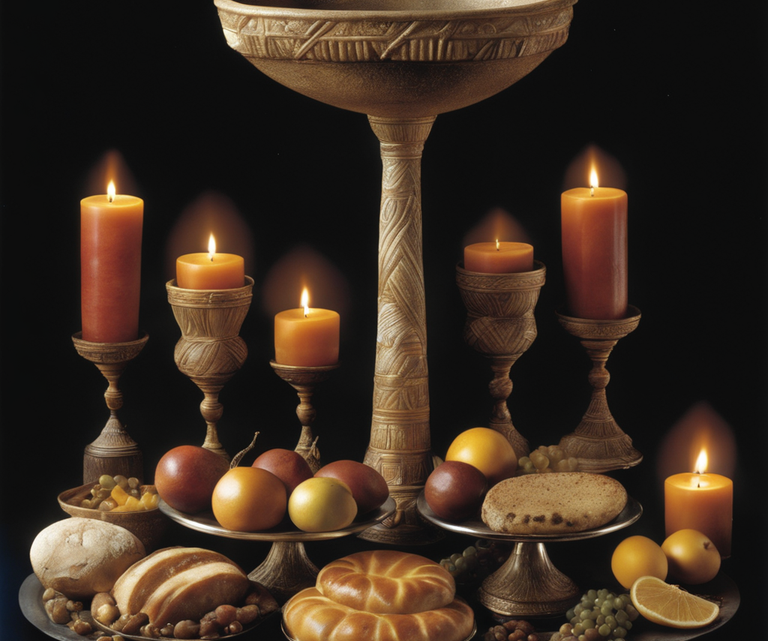Unveiling the Foundations: Yehovah’s Feasts, Roman Counterparts, and the Echoes in Scriptures — A Journey of Rediscovery


In the intricate tapestry of history woven with threads of diverse traditions and beliefs, the need to rediscover and adhere to the true path illuminated by Yehovah’s directives stands paramount. This expedition of rediscovery immerses us in the rich narratives from the scriptures, guiding us to distinguish Yehovah’s feasts from their Roman counterparts and to discern the symbols and objects that align with Yehovah’s commandments. Let us journey through the historic landscapes of these feasts, drawing from the stories etched in the scriptures, and envisage a path of worship that glorifies Yehovah and honors the Hebrew roots of our faith.
Pesach (Passover) and Easter
Pesach (Passover)
- Biblical Reference: Exodus 12
- Significance Pointing to Yeshua: The unleavened bread symbolizes Yeshua’s pure body and the wine represents his blood, portraying the freedom bought through his sacrifice (Luke 22:19-20). The Passover story of the Israelites’ deliverance from Egypt foreshadows the salvation we find in Yeshua.
Easter
- Historical Significance: Instituted in the 4th century during the Council of Nicaea, intertwining with the celebration of the goddess Eostre.
- Pagan Objects and Scriptural Warning: The adoption of eggs and Easter bunnies are deeply rooted in fertility rites and are not founded in the scriptures. In Judges 2:17, we are reminded of the Israelites’ deviation and the serving of other gods, a warning to remain true to Yehovah’s commands.
Shavuot (Weeks or Pentecost) and Pentecost Sunday
Shavuot (Weeks or Pentecost)
- Biblical Reference: Leviticus 23:15-22
- Significance Pointing to Yeshua: This feast, which celebrates the giving of the Torah, also prophesied the pouring out of the Holy Spirit, an event witnessed in the book of Acts during the Pentecost (Acts 2).
Pentecost Sunday
- Historical Significance: By the early centuries of the Christian church, Pentecost Sunday started straying from its Hebraic roots, losing much of its foundational significance.
- Pagan Objects and Scriptural Warning: Although not traditionally associated with pagan objects, the detachment from its Hebraic essence represents a drift away from scriptural authenticity.
Sukkot (Tabernacles) and Christmas
Sukkot (Tabernacles)
- Biblical Reference: Leviticus 23:33-43
- Significance Pointing to Yeshua: The festival foreshadows Yeshua’s incarnation, as seen in the narrative of his birth, likely aligning with the time of this feast (John 1:14).

Christmas
- Historical Significance: Officially instituted in the 4th century, borrowing elements from the pagan festival Saturnalia.
- Pagan Objects and Scriptural Warning: The introduction of spruce trees and other ornaments find their origin in pagan traditions, warned against in Jeremiah 10:2-4.
Yom Teruah (Feast of Trumpets) and New Year’s Eve
Yom Teruah (Feast of Trumpets)
- Biblical Reference: Leviticus 23:24-25
- Significance Pointing to Yeshua: The trumpets herald a day of joyful noise, aligning with prophesies in Thessalonians, hinting at Yeshua’s return with a trumpeter’s call (1 Thessalonians 4:16-17).
New Year’s Eve
- Historical Significance: The secular celebration dates back to 1582, influenced heavily by Roman mythology surrounding Janus, the god of beginnings.
- Pagan Objects and Scriptural Warning: Although devoid of specific pagan objects, the emphasis on revelry over spiritual reflection veers away from the solemnity of Yom Teruah.
Yom Kippur (Day of Atonement)
Yom Kippur (Day of Atonement)
- Biblical Reference: Leviticus 23:26-32
- Significance Pointing to Yeshua: The day echoes the deep intercession carried out by Yeshua as our High Priest, offering himself as a sacrifice (Hebrews 4:14-16).
Pagan Festivals and Halloween
- Historical Significance: Around the 9th century, Halloween amalgamated with the Roman festival Lemuria and the Celtic festival Samhain.
- Pagan Objects and Scriptural Warning: The use of demon masks is reminiscent of the idols warned against in Psalms 106:36-38, an admonition against the incorporation of pagan rituals that conjure spiritual
- entities contrary to Yehovah.
- Conclusion
- The journey through the scriptures is a vivid reminder to reconnect with our Hebraic roots, fostering a deeper understanding of Yehovah’s feasts and discerning the divergence brought about by Roman and pagan incorporations over centuries. By anchoring our beliefs and traditions in the rich narratives from the scriptures, we are called to reclaim a worship steeped in authenticity, one that honors Yeshua as the center of these feasts, nurturing a spiritual community grounded in truth and righteousness, in adherence to Yehovah’s guiding principles.
- As we navigate this path, let us take to heart the historical lessons and warnings contained within the scriptures, being diligent in separating the sacred from the profane, and seeking to celebrate Yehovah’s feasts with a purity of purpose and a reverence grounded in His divine precepts. Let this be a rallying call to return to the roots, to offer worship that truly reveres Yehovah, and to find in the scriptures the richness and depth of a faith founded on truth and obedience.

